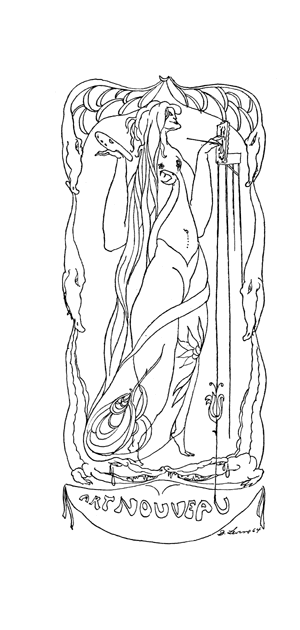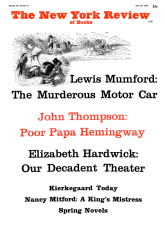The Savoy swaggered into precarious existence in 1895 with a name borrowed from the new London hotel. It offered thereby, a little facetiously, the same guilty plushness as the Yellow Book, then in trouble because it was assumed, mistakenly, to be the yellow volume that Oscar Wilde was carrying at the time of his arrest. The Savoy failed to supplant its rival and expired in 1896, after eight numbers, with a graceful editorial alas.
Stanley Weintraub, who two years ago edited a selection from the Yellow Book, has now made an anthology of the Savoy. Useful as it is, it perpetuates a notion of the magazine that is more dated than the magazine itself. By his eclectic choice of material, Mr. Weintraub endorses unquestioningly the Savoy’s claim to be interested in good writing of any school. He names Aubrey Beardsley as the one unifying agent. Beardsley designed the covers and most of the illustrations, characterized by androgyny and decorative excess; he also contributed four chapters of dilative prose, with the same qualities, entitled Under the Hill. But while Beardsley could preserve the magazine from respectability, always a danger, he was too frail in talent and perspective to give it substance. To say the magazine might have been called “The Beardsley,” a remark of Hesketh Pearson which Mr. Weintraub quotes with approval, is wrong as well as inept.
The editorial tendency is to flip and patronizing summaries. Beardsley is “the doomed young artist,” Arthur Symons is “a dedicated young literary jack-of-all-genres,” Leonard Smithers is “a pasty-faced pornographer.” Smithers did not actually write pornography; he published some, and with even more courage published as well some of the best writing of the time. Mr. Weintraub doesn’t avoid the inclination of literary historians of this period to fall into Ninety-ese; the men he describes are always “hitting bottom,” “dashing off a letter,” using allusions “with a vengeance,” or otherwise playing feverish, foolish roles in a pseudo-drama.
The Introduction perpetuates the literary gossip of the period and adds a few stories. It starts from the assumption that writers in the Nineties were trifling and dissolute and participated in a decade-long anecdote. Any period could be made to yield this kind of scene: It would be easy to “heighten” the fifteen years after the Nineties by offering as its principal events Yeats’s finally going to bed with Maud Gonne, Hugh Walpole’s unsuccessful advances to Henry James, Joyce’s elopement with a servant girl, and Pound’s sharing his digs one night with a burlesque queen. Such episodes have meaning in context, but ripped loose they turn history into a fragmentary series of escapades.
WHAT IS NEEDED is less anecdote, not more. The main fact about the Savoy is that it was edited by Arthur Symons at a time when he was sharing rooms, and therefore friends and ideas, with Yeats. The two extractable motifs of the magazine, neither mentioned by Mr. Weintraub, sprang directly from this association. The lesser one was that the Savoy became to a considerable extent the organ of a Pan-Celtic movement, with Symons the Cornishman, Ernest Rhys the Welshman, “Fiona MacLeod” the Scot, Shaw and Yeats the Irishmen, Vincent O’Sullivan the Irish American, and Lionel Johnson and his cousin Mrs. Olivia Shakespear, the first Celtic by adoption, the second by love of Yeats. This aspect of the magazine was never acknowledged though it is evident enough from the table of contents.
The more fundamental bias was towards symbolism. The importance of the Savoy was that it was the first and only English magazine to expound and illustrate this movement. Yeats of course supplied the center, with his three essays on Blake (not reprinted here) which relate Blake to Mallarmé and offer a theory of symbolist art. He contributes also his stories, “The Tables of the Law” and “Rosa Alchemica,” in which the narrator declares that for his mind “symbolism was a necessity,” and several ostentatiously symbolic poems like “The Secret Rose.” Symons’s own translations from Mallarmé were apposite, as was even a minor contribution like Olivia Shakespear’s “Beauty’s Hour.” Mr. Weintraub, who is perhaps less interested in this kind of art than in Shaw’s, confuses matters by saying that Symons was chosen editor of the Savoy after having published only one book, The Symbolist Movement in Literature, in 1889. But that book was not published until ten years later, in 1899, and the Savoy was the cause of it, not its by-product.
By neglecting the collaboration of Symons and Yeats, and by exaggerating the role of Beardsley, Mr. Weintraub deprives the magazine of individuality and real consequence. Granted that it was not single-minded, it was not a hodgepodge. The magazine did not take its direction from writers of repute who sent in their secondbest: Shaw indulges in some heavy fooling about churches, plumping for religionless religion; and Conrad in dense glooming about a French family with idiot children. These too share in one common feature of the magazine: While not exactly daring, it is at least eager to avoid propriety. A number of contributions, those of Beardsley and Yeats, Verlaine’s account of his English lecture tour (unhappily left out), some paragraphs of Symons and others, deserve attentive reading still. By its presentation of symbolism above all, the Savoy succeeded in being much more than an anti-Victorian flourish.
Advertisement
This Issue
April 28, 1966




